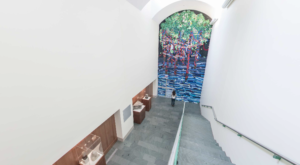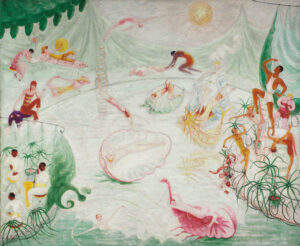Today’s post comes from Julie MacDonald, Class of 2012 and Art Center Student Docent.
The Frances Lehman Loeb Art Center is proud to present A Pioneering Collection: Master Drawings from the Crocker Art Museum. The exhibition features an exquisite collection of European drawings and will be on display in the Art Center through December 11, 2011. William Breazeale, Curator from the collection’s home at the Crocker Art Museum and organizer of this exhibition was kind enough to answer a few questions regarding the exhibition.
Julie MacDonald: What do you feel is the defining characteristic of the Crocker Art Museum as a whole, and what should any potential visitors hope to experience there?
William Breazeale: Our defining characteristic is variety. Besides a fine and early collection of Old Master drawings we are able to offer the public an unusual European paintings collection focused on the German-speaking world, the finest intact collection of early California painting, and small but growing collections of Asian, African, and Asmat art. The experience of the extensive contemporary California galleries especially reflects the many facets of art in museums today.
JM: Based in Sacramento, this is the first time pieces from the Crocker Art Museum have been displayed on the East Coast. What made you choose Vassar to exhibit the collection?
WB: Though paintings exhibitions organized by the Crocker have been seen in Washington, this is the first master drawings exhibition by a Crocker curator to come to the East. The reputation of the Frances Lehman Loeb Center and Vassar in the world of works on paper is high and longstanding, in terms of both exhibitions organized and exhibitions hosted. I have been aware of the Center for many years and have followed its activities even though I am based far away. I am delighted that the staff and director chose to support A Pioneering Collection, and that the public has responded so well.
JM: Although the Crockers may not be considered social activists, they were certainly progressive to the point of being married by Henry Ward Beecher. Do you feel this proclivity toward progressive social consciousness influenced their later art patronage?
WB: What the Crockers share with today’s patrons is a concern for improvement of their surroundings through supporting–and in their case creating–institutions with a specific mission. These did include addressing problems they perceived in society, in the case of Mrs. Crocker’s Marguerite Home, which served as a residence for aged women. The fact art can improve all our lives, which is something I sense they believed deeply, the Crocker family must have had in mind when they collected art for a young California. They collected and commissioned what was then contemporary art, both German and Californian, though by artists whose criticism of society was limited. So the improvement of society’s ills through pointing out its faults as represented by artists–something that has become very important in the years since–does not seem to have been part of their plan.
JM: It seems to me that throughout much of the history of the Crocker Collection the master drawings were typically overlooked, and even unappreciated, until the work of Numa S. Trivas beginning in 1940. What inspired you to pick up his cause and become today’s champion of these works?
WB: A master drawings collection of the quality found at the Crocker Art Museum is a rare thing. I came to know the collection through exhibitions organized by other institutions, and decided to explore further–it seemed perhaps that the time was ripe for a Crocker curator to advance knowledge of the drawings. I do not know that the collection was unappreciated, certainly by specialists, in the years after Trivas’s death, though it is true that exhibitions were relatively rare. Early on, though his efforts were limited by distance, the first curator at the Crocker, William F. Jackson, was an advocate for the collection. It was the presence of Numa S. Trivas and other curators trained in Europe in 1930s California–and the fact that systematic study of drawings was becoming more widespread in the United States–that brought the collection to the larger drawings world.
JM: What do you hope every visitor will take away from the exhibition?
WB: I think every drawings exhibition, and I hope this one too, is about close looking and thinking about the artist’s process. How was it made? Why? How did the artist achieve his intent? These are the questions that fascinate me, and I hope will fascinate viewers.
Our thanks to William Breazeale and the Crocker Art Museum for bringing A Pioneering Collection to the Art Center.






Hello there! Quick question that’s totally off topic. Do you know how to make your site mobile friendly? My blog looks weird when browsing from my iphone 4. I’m trying to find a template or plugin that might be able to resolve this issue. If you have any suggestions, please share. Appreciate it!
A great blog. I’m following you
howdy-do, Thanks for this blog post i find it hard to track down smart important info out there when it comes to this subject materialappreciate for the information this information helped me in my research, Thank you.